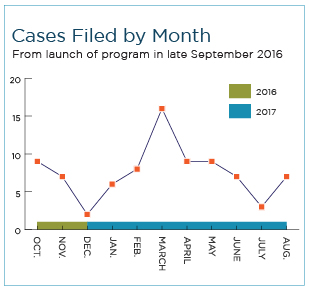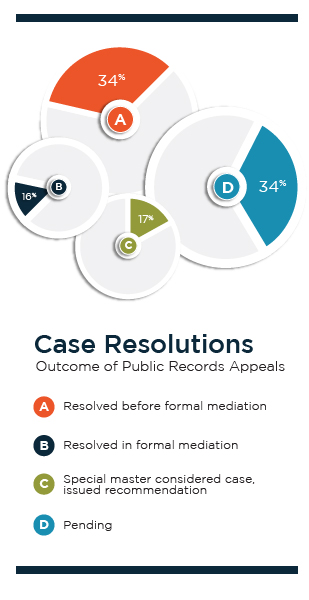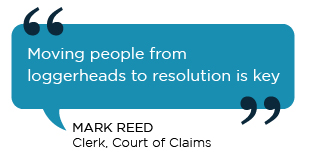Public Records Reboot
BY THE NUMBERS


BY THE NUMBERS


Last September, legislation took effect that launched a new way for people who think they’ve been wrongfully denied a public record to challenge their lack of access. The law aims to offer “an expeditious and economical procedure that attempts to resolve disputes” about public records. The appeals are heard in the Ohio Court of Claims, which handles most civil lawsuits against the state, including public agencies and state universities.
One year has passed, and the court accepted 82 public records cases through Aug. 30. Of those, a substantial 75 percent (41 of 55 completed cases) have been resolved through mediation. The resolution of these disputes outside the courtroom forms the foundation of this retooled approach to public records appeals.
It even says so in the statute. The court is mandated to hold, or “stay,” every public records case it accepts and first turn it over for mediation, unless the designated “special master” to these disputes determines it’s “in the interest of justice” not to mediate the matter.
Court Reaches Out to Public Agencies
Once a case moves to mediation, an “initial triage” takes place, said Mark Reed, clerk of the court.
Reed and the court’s special master in public records cases, Jeff Clark, review every public records filing. Clark, whose experience includes 10 years working on public records matters with the Attorney General’s Office, makes notes for the staff, offering his initial perspective on the points of contention and the law. A staff attorney then typically makes a phone call to the public agency that hasn’t produced the record. During these discussions, the staff attorney may educate both the agency and the person requesting the record about specific parts of Ohio’s public records act and court decisions relevant to the dispute, Clark said.
He describes the phase as “shuttle diplomacy,” where the attorney goes back and forth between the parties to see if the initial information and suggestions can sort out the frustrations and issues. This opening dialogue so far has resolved about one third of the court’s public records cases.
Dani Carlson, a reporter for Cleveland TV station WOIO, last year wanted to obtain the personnel record of a former employee with the city of Green. When she was denied the record, the station sent a letter to the city in spring 2016 explaining reasons the news outlet thought it was entitled to the documents. That went nowhere, Carlson said. A reporter in a journalists’ organization told her that the new law was expected to go into effect in the fall, and she saw an alternative.
“I was looking for a way to fight for access to this record without going through a costly legal process,” Carlson said.
She has high praise for the Court of Claims’ employees who work on these cases.
“The staff is fantastic. They’re very helpful human beings,” she said, describing how they guided her through each step in the process. Carlson eventually received the Green records and records she requested in four other cases.


Mediation Sorts Out Many Issues
If the disagreement isn’t resolved during the initial discussions with the court, the next step is formal mediation. The court schedules a phone mediation, usually with Reed. Sometimes it’s a joint discussion with both parties on the phone; other times, Reed talks separately with each side to frankly review the risks and benefits of a party’s choices in the dispute. The calls typically take 45 to 90 minutes.
“Moving people from loggerheads to resolution is key,” Reed said.
Carlson said the mediation by phone in the Green case saved the expense in time and money for traveling to Columbus, where the Court of Claims is located. Reed first discussed the issues with her, Carlson said, then he separately talked with the city’s representatives. Because she isn’t a lawyer and represented herself, the reporter said she appreciated the approach, which she found less intimidating.
The staff tries to schedule mediations at times convenient for the parties – in the evening if necessary. The court’s flexibility helps not only the person requesting the record, who may be someone who works during the day, but also the public agency, Clark said. Some public entity officials are from smaller localities, such as a township or a village whose trustees or officers may hold only part-time positions.
Although mediation isn’t always successful, Reed has been impressed by the good will of everyone involved to date, noticing that each side usually enters the discussion with ideas how to resolve the dispute.


Designed as Better Method
The law clearly envisioned an easier path to sort out public records disagreements that already have some precedent for how to resolve, Clark said. According to the statute, if a public records case filed with the Court of Claims presents a novel legal issue of substantial public interest, it must be dismissed and filed in the appropriate court of appeals as a writ of mandamus. The writ was the standard way to make a public records claim before this law passed.
“A writ of mandamus is a full-blown civil action,” Reed explained. “It’s expensive and not an easy legal process, even for lawyers.”
The General Assembly’s desire to implement a simplified method to settle public records disagreements is evidenced by the low $25 filing fee, the tight timeframes to move through each step in the process, and the preference for mediation over adjudication, Reed noted. The law also specifically curtails discovery, motions, and pleadings, which Reed said “prevents a lot of legal maneuvering.”
“It gives self-represented litigants access to a court to hear their claim fairly quickly and get a quick up-or-down decision on whether they have a right to the record they’re requesting,” Reed said. “It provides the public with greater access to justice.”
Requests Must Be Specific
Clark noted that the positive mediation outcomes in the Court of Claims program built on the successful public records mediation program pioneered by the Attorney General’s Office. Damian Sikora, who oversees the attorney general’s public records unit that represents state agencies in these disputes, has found the disagreements often reflect miscommunication or lack of clarity about what’s being requested.
Reed and Clark agree that determining what record the person making the request truly is seeking can steer a case toward resolution. Reed recalled a situation in which a member of the public wanted to know technical information about security equipment bought for a jail. That raised security concerns from officials about releasing such details. When the requester was asked what he hoped to know, he explained he was interested in what the county paid for the equipment, Reed said, noting that the county easily provided a purchase order showing the cost but no technical specifications.
“Sometimes those asking for records try to model their request on ‘any and all’ language that lawyers use in public records lawsuits, and then the request is overly broad,” Reed said. The court encourages requesters to succinctly state what they are looking for in plain language.
On the public entity side, Reed noted that 70 of Ohio’s counties are rural, many with public agencies that have limited funding and employees. He has found that these agencies sometimes haven’t had time to respond to a public records request because of workloads or short-staffing, but once alerted to their obligations they often produce the record.
In Sikora’s view, the court is “finding a groove” with the new program. Over time, the mediations have become smoother, shorter, and more focused, he said of the 17 cases his office has handled. They’ve been surprised, though, that advising clients, writing briefs, and general preparation still has been as time intensive as a traditional mandamus action for public records.
“It’s a good start,” he said. “Anytime you get people on the phone and talking with each other, it’s better than emails passing through the night.”
Positive Step with More Potential
If the case doesn’t settle, the public agency must file a formal response to the complaint, and Clark most often acts as the special master, who takes the case to completion. Cases that reach this point – 17 percent so far – are more complex and can require a deeper review. The special master can direct the parties to submit additional arguments, information, or documentation, including the denied records for the court’s private inspection. From this vantage point, the special master then issues a report and recommendation about whether a record is required by law to be released. Either party may object to the report and recommendation during a seven-business-day window, after which the Court of Claims makes a final decision. The court’s rulings can be appealed back to the appellate district where the public entity is located, but to date only two cases have gone that route.
Carlson believes the program is “a good step but not perfect.” She thinks the process still can be difficult for someone unfamiliar with the legal system, explaining that she had to research the public records law and write her own briefs for cases that reached Clark.
“A regular person is at a bit of a disadvantage,” she said. She has had success through the program and recommends the streamlined process to others, but wonders whether it’s changing the culture of agencies that are reluctant to release records or don’t fulfill requests within a reasonable time.
Clark hopes agencies are applying what he describes as the excellent public records training available through the attorney general and state auditor, and are using modern technology to simplify the process for themselves and citizen requesters. For example, in a case involving the release of police and fire call logs, he informed the municipality that other agencies have adopted a practice of posting all call logs on their web sites. Its staff balked initially, stating that they’re not required to do that. Clark suggested it as an option because online availability would eliminate the time and effort to fulfill individual requests for the logs one by one.
“Why fix only one case when you can address the bigger problem?” Clark said. “Maybe it will improve the process for all.”
He points to other advantages of the program: the availability of a centralized court for any public records appeal; electronic filing of documents with the court; no attorney fees; and the low $25 cost to file a complaint. Although some public agencies have to hire and pay a lawyer to defend these suits, the shorter timeframes keep those costs lower than a traditional public records lawsuit, he said.
Whenever possible, the Attorney General’s Office also makes it a priority to educate public agencies and others about the Court of Claims procedure.
“We appreciate the importance of releasing public records and complying with the public records law,” Sikora said. “We use the Court of Claims program to remind clients of the consequences if they don’t meet their obligations under Ohio law.”
“Openness and transparency in government is necessary for an informed, participatory democracy,” Clark added. “Expediting a reporter’s or private citizen’s request through this program helps make information available, in a more timely way, for public review and debate.”
“This program was needed. I’m convinced of that,” Reed noted. “I don’t think our current caseload is our upper limit. I would like to see citizens’ needs for access to public records met, and I don’t think we’re fully filling that need yet.”


